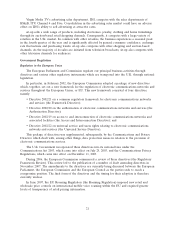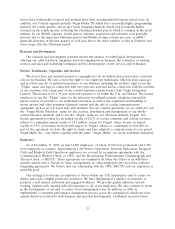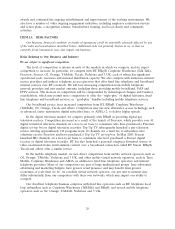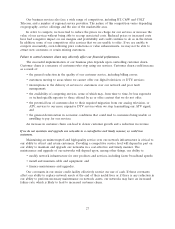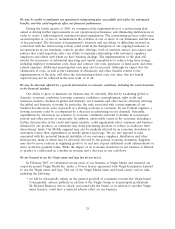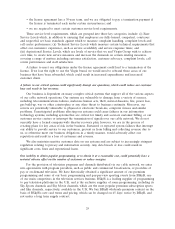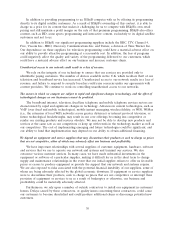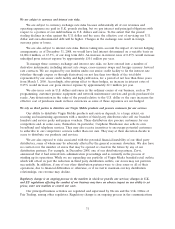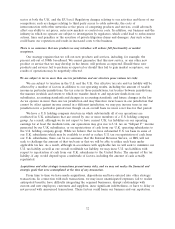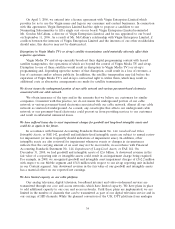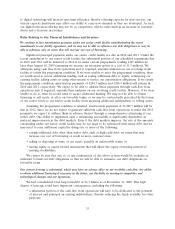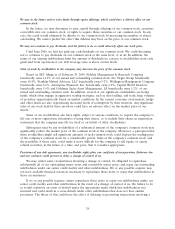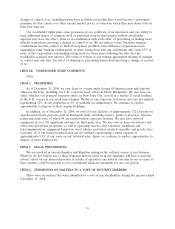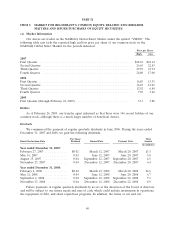Virgin Media 2008 Annual Report Download - page 33
Download and view the complete annual report
Please find page 33 of the 2008 Virgin Media annual report below. You can navigate through the pages in the report by either clicking on the pages listed below, or by using the keyword search tool below to find specific information within the annual report.We are subject to currency and interest rate risks.
We are subject to currency exchange rate risks because substantially all of our revenues and
operating expenses are paid in U.K. pounds sterling, but we pay interest and principal obligations with
respect to a portion of our indebtedness in U.S. dollars and euros. To the extent that the pound
sterling declines in value against the U.S. dollar and the euro, the effective cost of servicing our U.S.
dollar and euro-denominated debt will be higher. Changes in the exchange rate result in foreign
currency gains or losses.
We are also subject to interest rate risks. Before taking into account the impact of current hedging
arrangements, as of December 31, 2008, we would have had interest determined on a variable basis on
£4,004.4 million, or 67.3%, of our long term debt. An increase in interest rates of 0.25% would increase
unhedged gross interest expense by approximately £10.1 million per year.
To manage these currency exchange and interest rate risks, we have entered into a number of
derivative instruments, including interest rate swaps, cross-currency swaps and foreign currency forward
rate contracts. We are required by our lenders under our senior credit facility to fix the interest rate
(whether through coupon or through derivatives) on not less than two-thirds of the total debt
represented by our senior credit facility and high yield notes, for a period of not less than three years
from March 3, 2006. Accordingly, after giving effect to these hedges, an increase in interest rates of
0.25% would increase our gross interest expense by approximately £2.1 million per year.
We also incur costs in U.S. dollars and euros in the ordinary course of our business, such as TV
programming, customer premise equipment and network maintenance services and goods purchased for
resale. Any deterioration in the value of the pound relative to the U.S. dollar or the euro increases the
effective cost of purchases made in these currencies as some of these exposures are not hedged.
We rely on third parties to distribute our Virgin Mobile products and procure customers for our services.
Our ability to distribute Virgin Mobile products and services depends, to a large extent, on
securing and maintaining agreements with a number of third party distributors who sell our branded
handsets and service packs and prepay vouchers. These distributors also procure customers for our
competitors and, in some cases, themselves. In particular, Carphone Warehouse also sells its own
broadband and telephone services. They may also receive incentives to encourage potential customers
to subscribe to our competitors’ services rather than our own. They may at their discretion decide to
cease to distribute our products and services.
We are also exposed to risks associated with the potential financial instability of our third party
distributors, some of whom may be adversely affected by the general economic downturn. We also have
no control over the number of stores that may be opened or closed in the future by any of our
distribution partners. For example, in December 2008, one of our distribution partners, Zavvi,
announced that it had entered into administration proceedings and is currently in the process of
winding up its operations. While we are expanding our portfolio of Virgin Media branded retail outlets,
which will off-set in part the reduction in third party distribution outlets, our stores may not perform
successfully. In addition, if any of our other distribution partners were to close some or all of their
operations, due to financial difficulties or otherwise, or if we fail to maintain our key distribution
relationships, our revenue may decline.
Regulatory change is an ongoing process in the markets in which we provide our services; changes in U.K.
and EU regulations affecting the conduct of our business may have an adverse impact on our ability to set
prices, enter new markets or control our costs.
Our principal business activities are regulated and supervised by Ofcom and the U.K. Office of
Fair Trading, among other regulators. Regulatory change is an ongoing process in the communications
31


